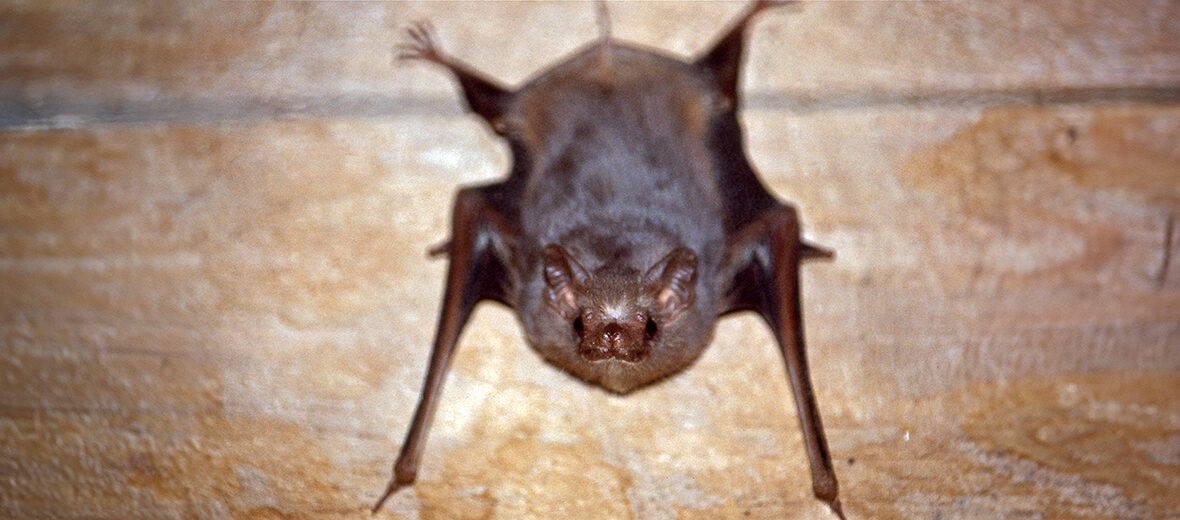
The gray sac-winged bat can be found in Mexico, Baja California, and Central America. There are 51 known species of sac-winged bats. They are a species in the family Emballonuridae. These bats face the threats of habitat loss and destruction due to vandalism and fires caused by humans in the bat’s caves. The IUCN lists these bats as Least Concern; however their population trend is unknown, so that classification could change.
First the Stats…
Scientific name: Balantiopteryx plicata
Weight: Up to .25 ounce
Length: Up to 2.62 inches
Wingspan: Up to 8+ inches
Lifespan: Up to 6 years
Now on to the Facts!
1.) These bats dwell at elevations of up to 4,900 feet.
2.) They were first described in 1867 by German naturalist and explorer Wilhelm Peters.
3.) The name Balantiopteryx hails from the Greek word meaning “pouch wing”. The name “plicata” hails from the Latin word meaning “folded”.
4.) Their other common name is Peters’ sac-winged bat.
5.) They get their name from the sacs situated between the wrist and the neck on the membrane of the wing, which is much more pronounced and developed in males than in females.
But wait, there’s more on the gray sac-winged bat!
6.) A typical feature among these bats is their sheath tail. That is to say that there is a membrane which stretches from 1 of the bat’s ankles to the other, and most of the tail is covered by the membrane, with just the tail tip protruding.
7.) Gray sac-winged bats prefer to dwell in the mouths of caves, in barns, and other buildings; typically in areas that are open and lit.
Did you know…?
Colonies are typically comprised of up to approximately 25% females and 75% males. However, these stats vary.
8.) These bats are gregarious and can be found in colonies of up to 50 individuals.
9.) That being said, some colonies can reach sizes of up to 10,000 strong!
10.) A group of bats is called a camp, cloud, colony, or flock.
But wait, there’s still more on the gray sac-winged bat!
11.) When roosting they tend to stay up to 7.87 inches apart from one another.
12.) Bats are able to sleep upside down without blood rushing to their head the same way humans and other terrestrial animals can stand without blood rushing to the feet. This is accomplished via special valves and muscles.
Did you know…?
When they are roosting, all the individuals face the same direction.
13.) Bats also hang upside down because, unlike birds, they can’t take off from a standing or resting position. Therefor, they drop from the ceiling, expand their wings, and begin flying.
14.) Being opportunistic foragers, these insectivores (eat insects) feed an a wide variety of flying insects such as moths, butterflies, mosquitoes, and beetles.
15.) These little bats are slow in flight and reach speeds up to only 6.06 mph. Females are a little slower than males at just 5.68 mph.
But wait, there’s still a little more on the gray sac-winged bat!
16.) Studies have concluded that when bats are able to see more clearly they tend to rely on their vision rather than echolocation (the location of objects by reflected sound).
17.) In an interesting experiment, these bats were placed in a framed mesh greenhouse (to avoid injury) and observed at dawn, dusk, day, and night. During the lighter times of the day, the bats ran into the ceiling and walls of the enclosure, but at night, when relying solely on echolocation, they avoided these obstacles completely.
Did you know…?
Pups can fly in up to 2 weeks and are completely weaned in 9 weeks.
18.) The pulses they emit are produced via their mouth and are audible to humans.
19.) Females are monoestrous (only produce 1 offspring) and undergo up to a 4.5 month gestation (pregnancy) that produces a single pup.
20.) Due to the selfless weaning of the mother, females that have birthed a pup have merely a 54% survival rate.
But wait, there’s still a tad more on the gray sac-winged bat!
21.) Barn owls, spotted skunks, coatis, hawks, domestic cats, and dogs all prey on these bats.
22.) Ants, cockroaches, rock crabs, and dermestid larvae all feast on the guano (bat poop) left by these bats; the rock crab may also eat the fallen dead bats as well.
Did you know…?
These critters seem unaffected by rabies.
23.) Besides being preyed on by birds and mammals, they are also troubled red mites, that feed on their ear edges, ticks, bat flies, lice, and fleas.
24.) They are also troubled by internal parasites such as trematodes, cestodes, and nematodes.
25.) Gray sac-winged bats are often found in caves with other bat species.
Now a Short Gray Sac-Winged Bat Video!
This video is about sac-winged bats, in general.
Be sure to share & comment below! Also, check out the Critter Science YouTube channel. Videos added regularly!
Want to suggest a critter for me to write about? Let me know here.
Some source material acquired from: Wikipedia & IUCN
Photo credit: Bernard DUPONT




